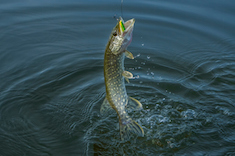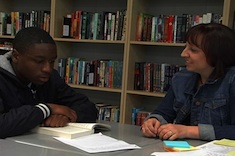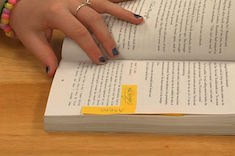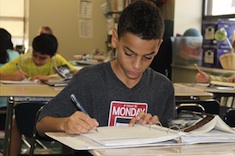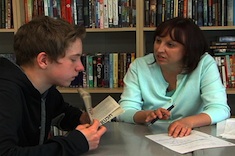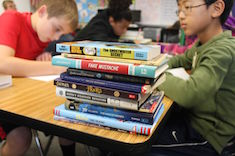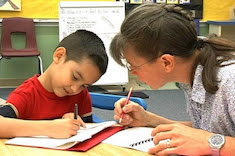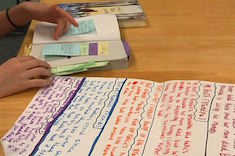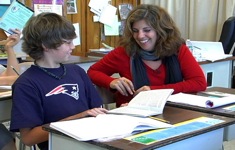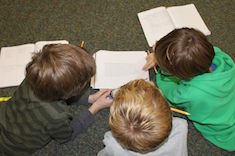Library
Choice Literacy Articles & Videos
The Choice Literacy library contains over 3,000 articles and 900 videos from 150+ contributors. Classic Classroom and Literacy Leadership subscribers have access to the entire library. Content is updated continuously, with five to six new features published each week.
Latest Content
Flipping Negative Teacher Emotions
Gretchen Schroeder struggles to understand the meaning and value of her teaching when two former students overdose and die, another pleads guilty to murder, and yet another is arrested for domestic violence. She also looks at the corrosive effects of both apathy and envy. The result is a deep reflection on how teachers can move beyond sadness and other difficult emotions.
Three-Word Meditation
Mark Levine depends upon a simple meditation strategy during the required moment of silence in his classroom to begin each day with a calm sense of purpose.
Recharging with My Tribe
Stella Villalba uses the inquiry and reflection skills she has developed as a teacher to pore through her planner and journal for clues to why her energy flagged in the winter and spring, and what she can do differently next year.
Student Notes: Reading for Writing
Reagan, a fifth grader in Franki Sibberson's class, explains how she uses sticky notes to flag examples of writer's craft she could use in her own writing.
The Big Fresh June 16, 2018 Old Boat
We look at how to teach theme to teens and tweens in this week’s Big Fresh.
Splashing Around to Find Themes
Christy Rush-Levine moves from emphasizing theme to teaching strategies for understanding text, and finds it’s a much better way to get her eighth graders to grapple with theme in natural, organic ways.
Getting to the Heart of Theme
Tara Smith shares many strategies for helping her sixth graders get to the heart of understanding themes in literature.
From Title to Theme: Conferring with Jadev
Christy Rush-Levine confers with Jadev about how the title of a book often gives clues to its theme.
Student Notes: Reminders for Later
We continue our video series from Franki Sibberson's class of fifth graders explaining how they take notes while reading. Sarah marks important elements early in the mystery she is reading, so she can easily refer to them later.
The Big Fresh June 9, 2018 Free Range
We consider the importance of background knowledge in this week’s Big Fresh.
Writing Routines: Drafting Autonomy
Justin Stygles questions his conferring routine during writing workshops, and the value of interrupting students early in the drafting process.
Understanding War: Conferring with Cam
Christy Rush-Levine confers with Cam, an eighth grader who seeks to understand the complexity of war through the experiences of main characters in novels.
Comics and Graphic Novels for Tweens
Comic books and graphic novels are genres tweens adore, but teachers sometimes struggle to embrace. Ruth Shagoury creates a booklist with engaging books in the genre any teacher would enjoy.
Refugees: A Children’s Booklist
There is probably no population more misunderstood or vilified than refugees. Stella Villalba shares a booklist to help young students understand the refugee's plight and experiences.
Student Notes: Keeping Track of Many Characters
Tre uses lots of sticky notes to sort through and keep track of characters in a book with a whole classroom full of personalities.
The Big Fresh June 2, 2018 Memory
We explore how to take better notes in this week’s Big Fresh.
Conference Records That Stay with Kids
Ruth Ayres explains why conferring records that stay with kids are useful for teachers.
Conferring Notes
When it comes to conferring notes, form needs to follow function. Dana Murphy quit looking for the perfect template, and started focusing on what kinds of notes are most helpful.
Student Notes: Experimenting with Two Strategies
What do student notes from independent reading look like when students have free choice? In this video series, fifth graders from Franki Sibberson's class explain their notetaking strategies. We start with Ally, who tries out two different strategies to figure out which one will help her the most.
Conferring: Establishing a Setting in a Novel
In this week's video, Aimee Buckner has a quick conference with a fourth grader about ways to solve a dilemma — how to figure out the setting in a historical fiction novel when there are no pictures.
The Big Fresh May 26, 2018 Everyday Subversions
We consider the importance of background knowledge in this week’s Big Fresh.
Launching a Historical Fiction Genre Study
Tara Smith finds her sixth graders love historical fiction, but they often lack the background knowledge to understand texts fully. She launches her historical fiction unit with a careful mix of discussion, anchor charts, and shared texts.
Content and Context
Melanie Meehan considers content and context for students who struggle to master new skills because of a lack of background knowledge.
Leads Minilesson
This fifth-grade minilesson from Franki Sibberson is a lovely mix of mentor texts, Franki's own writing, and honesty about the writing process.
The Big Fresh May 19, 2018 Style
We look at middle school reading and writing workshops in this week’s Big Fresh.
Rethinking Spring Assessments
It's May, and teachers everywhere are preparing for final assessments of students. Jennifer Schwanke explains why it might be time to rethink or even ditch some of those plans.
Using a Storyboard for Reflection and Comprehension
Christy Rush-Levine shows a group of three students how they can use a storyboard to help track thinking while reading.
More Scholarly Discussions in Middle School
“Eat my shorts!” Christy Rush-Levine overhears a student comment in a literature group, and begins a quest to teach her students strategies for more appropriate and thoughtful conversations around texts.
Know and Wonder: Deepening Reflection at the Start of Texts
Tara Barnett and Kate Mills use a know-and-wonder activity to encourage curiosity and independence as their seventh graders begin a new text.
The Big Fresh May 12, 2018 Appearances
We look at the power of classroom talk in this week’s Big Fresh.
Browse Content By
Type
Category
- Assessment Tools
- Big Fresh Archives
- Booklists
- Choice Numeracy
- Classroom Design
- Common Core
- Community Building
- Conferring
- Content Literacy
- Digital Literacy
- English Language Learners
- Equity
- Family Relations
- Free Samples
- Guiding Groups
- Leadership
- Literacy Coaches
- Mentor Texts
- Minilessons
- New Teacher Mentors
- Podcasts
- Poetry
- Quote Collections
- Reading Strategies
- Self Care
- Struggling and Striving Learners
- Talking and Listening
- Teacher Study Groups
- Teaching Reading
- Teaching Writing
- Word Study and Vocabulary
Author
- Melissa Quimby
- Nawal Qarooni
- Gwen Blumberg
- Julie Cox
- The Lead Learners
- Hannah Tills
- Josie Stewart
- Ruth Metcalfe
- Mallory Messenger
- Becca Burk
- Jodie Bailey
- Vivian Chen
- Mary Brower
- Tiffany Abbott Fuller
- Stephanie Affinito
- Ruth Ayres
- Leigh Anne Eck
- Heather Fisher
- Shari Frost
- Julie Johnson
- Suzy Kaback
- Gigi McAllister
- Shirl McPhillips
- Melanie Meehan
- Cathy Mere
- Debbie Miller
- Tara Barnett and Kate Mills
- Tammy Mulligan
- Dana Murphy
- Bitsy Parks
- David Pittman
- Brenda Power
- Heather Rader
- Matt Renwick
- Mandy Robek
- Christy Rush-Levine
- Gretchen Schroeder
- Jen Schwanke
- Brian Sepe
- Katherine Sokolowski
- Stella Villalba
- Jennifer Vincent
Grade Level
Choice Literacy Membership
Articles
Get full access to all Choice Literacy article content
Videos
Get full access to all Choice Literacy video content
Courses
Access Choice Literacy course curriculum and training






